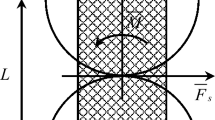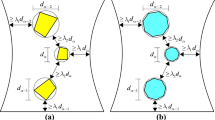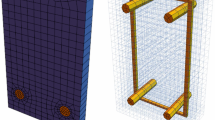Abstract
In this paper, a new multi-scale numerical model is presented using meshless element free Galerkin (EFG) method to simulate the multi-scale constitutive relation of concrete. The scale separation is based on the decomposition of the mesh free shape function into α and β scales, similar decomposition is also adopted for the constitutive equations. And the constitutive relations in different scales for concrete are established. The multi-scale EFG model is utilized for discretization of components of concrete block, which are aggregate, cement and transition region. The strengths of these components are adopted according to Weibull distribution. Consequently, the multi-scale EFG model is applied to describe the evolutionary processes of damage, the propagation of cracks and the characteristics of hysteresis of concrete. The plain static analysis of concrete block is performed by using this model and the calculated result is discussed.








Similar content being viewed by others
References
Bazant, Z.P., Caner, F.C., Adley, M.D., Akers, S.A.: Fracturing rate effect and creep in microplane model for dynamics. J. Eng. Mech. 9, 962–970 (2000b)
Bazant, Z.P., Caner, F.C., Carol, I., Adley, M.D., Akers, S.A.: Microplane model M4 for concrete. I: formulation with work-conjugate deviatoric stress. J. Eng. Mech. 9, 944–953 (2000a)
Bazant, Z.P., Tabbara, M.R., Kazemi, M.T., et al.: Random particle models for fracture of aggregate or fiber composites. J. Eng. Mech. 116(8), 1686–1705 (1990)
Belytschko, T., Krongauz, Y., Organ, D., Fleming, M., Krysl, P.: Meshless methods: an overview and recent developments. Comput. Meth. Appl. Mech. Eng. 139, 3–47 (1996)
Belytschko, T., Lu, Y.Y., Gu, L.: Element-free Galerkin methods. Int. J. Numer. Meth. Eng. 37, 229–256 (1994)
Carpinteri, A., Chiaia, B., Cornetti, P.: On the mechanics of quasi-brittle materials with a fractal microstructure. J. Eng. Fract. Mech. 70, 2321–2349 (2003)
Cusatis, G., Bazant, Z.P.: F.ASCE, Luigi Cedolin, M.ASCE. Confinement-Shear Lattice Model for Concrete Damage in Tension and Compression: I. Theory. J. Eng. Mech.129(12), 1439–1448 (2003)
De Schutter, G., Taerwe, L.: Random particle model for concrete based on delaunay triangulation. Mater. Struct. 26(156), 67–73 (1993)
Gao, H.J., Klein, P.: Numerical simulation of crack growth in an isotropic solid with randomized internal cohesive bond. J. Mech. Phys Solids 46(2), 187–218 (1998)
Gingold, R.A., Monaghan, J.J.: Smoothed particle hydrodynamics, theory and application to non-spherical stars. Men. Not. R. Astron. Soc. 181, 375–389 (1977)
Jibo, X.I.N.G., Liangqun, Y.U.: Study of fracture behavior particle composites with beam-aggregate model. J. Basic Sci. Eng. 5(2), 193–198 (1997)
Jie, Li.: Research on the stochastic damage mechanics for concrete materials and structures. J. Tongji Univ. 32(1), 75–85 (2004)
Nayroles, B., Touzot, G., Villon, P.: Generalizing the finite element method: diffuse approximation and diffuse elements. Comput. Mech. 10, 307–318 (1992)
Schlangen, E., Garboczi, E.J.: New method for simulating fracture using an elastically uniform random geometry lattice. Int. J. Eng. Sci. 34(10), 1131–1144 (1996)
Schlangen, E., Garboczi, E.J.: Fracture simulations of concrete using lattice model: computational aspects. Eng. Fract. Mech. 57(2–3), 319–332 (1997)
Tang, C.A.: Numerical simulation of rock failure and associated seismicity. Int. J Rock Mech. Min. Sci. 34, 249–262 (1997)
Wei, J.-x., Yu, Q.-j., Zeng, X.-x., Bai, R.-y.: Fractal dimension of pore structure of concrete. J. South China Univ. Technol. 35(2), 121–124 (2007)
Wittmann, F.H.: Structure of Concrete with Respect to Crack Formation, pp. 43–74. Elsevier Science Publishers, Netherlands (1989)
Yuncheng, L.I., Hhuaifa, M.A., Xiao, C.H.E.N.: Analysis of Concrete3-D meso-mechanical Model. J. Shandong Inst. Commer. Technol. 7(3), 98–101 (2007)
Yuncheng, L.I., Hhuaifa, M.A., Huoqun, C.H.E.N., Xiao, X.U.: Approach to generation of random convex polyhedral aggregate model and plotting for concrete meso-mechanics. J. Hydraul. Eng. 5, 588–592 (2006)
Zhang, Z.N., Ge, X.R.: A new quasi-continuum constitutive model for crack growth in an isotropic solid [J]. Eur. J. Mech. Solids 24(2), 243–252 (2005a)
Zhang, Z.N., Ge, X.R.: Micromechanical consideration of tensile crack behavior based on virtual internal bond in contrast to cohesive stress. Theor. Appl. Fract. Mech. 43(3), 342–359 (2005b)
Author information
Authors and Affiliations
Corresponding author
Rights and permissions
About this article
Cite this article
xu, Q., Chen, J. & Li, J. Multi-scale EFG model for Simulating Concrete Material. Int J Mech Mater Des 8, 113–120 (2012). https://doi.org/10.1007/s10999-012-9180-z
Received:
Accepted:
Published:
Issue Date:
DOI: https://doi.org/10.1007/s10999-012-9180-z




